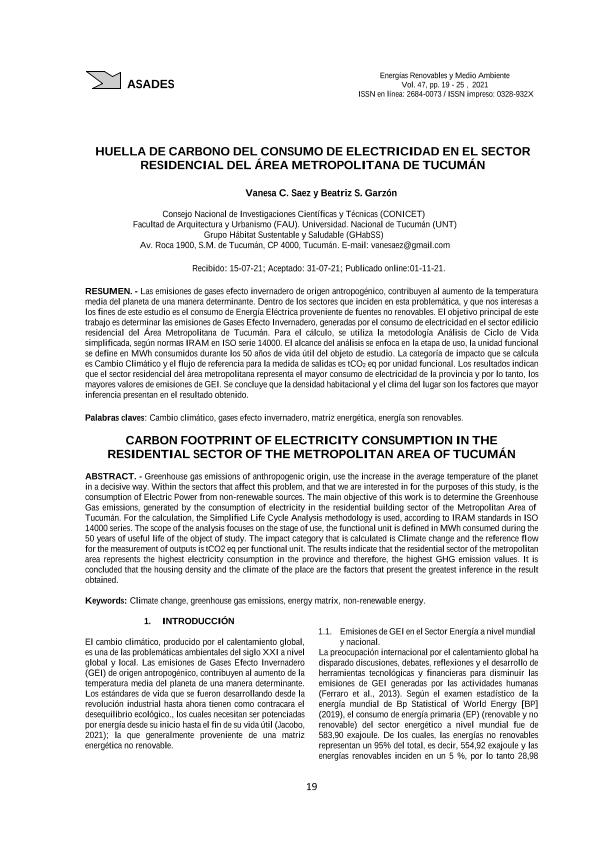Artículo
Las emisiones de gases efecto invernadero de origen antropogénico, contribuyen al aumento de la temperatura media del planeta de una manera determinante. Dentro de los sectores que inciden en esta problemática, y que nos interesas a los fines de este estudio es el consumo de Energía Eléctrica proveniente de fuentes no renovables. El objetivo principal de este trabajo es determinar las emisiones de Gases Efecto Invernadero, generadas por el consumo de electricidad en el sector edilicio residencial del Área Metropolitana de Tucumán. Para el cálculo, se utiliza la metodología Análisis de Ciclo de Vida simplificada, según normas IRAM en ISO serie 14000. El alcance del análisis se enfoca en la etapa de uso, la unidad funcional se define en MWh consumidos durante los 50 años de vida útil del objeto de estudio. La categoría de impacto que se calcula es Cambio Climático y el flujo de referencia para la medida de salidas es tCO2 eq por unidad funcional. Los resultados indican que el sector residencial del área metropolitana representa el mayor consumo de electricidad de la provincia y por lo tanto, los mayores valores de emisiones de GEI. Se concluye que la densidad habitacional y el clima del lugar son los factores que mayor inferencia presentan en el resultado obtenido. Greenhouse gas emissions of anthropogenic origin, use the increase in the average temperature of the planet in a decisive way. Within the sectors that affect this problem, and that we are interested in for the purposes of this study, is the consumption of Electric Power from non-renewable sources. The main objective of this work is to determine the Greenhouse Gas emissions, generated by the consumption of electricity in the residential building sector of the Metropolitan Area of Tucumán. For the calculation, the Simplified Life Cycle Analysis methodology is used, according to IRAM standards in ISO 14000 series. The scope of the analysis focuses on the stage of use, the functional unit is defined in MWh consumed during the 50 years of useful life of the object of study. The impact category that is calculated is Climate change and the reference flow for the measurement of outputs is tCO2 eq per functional unit. The results indicate that the residential sector of the metropolitan area represents the highest electricity consumption in the province and therefore, the highest GHG emission values. It is concluded that the housing density and the climate of the place are the factors that present the greatest inference in the result obtained.
Huella de carbono del consumo de electricidad en el sector residencial del área metropolitana de Tucumán
Título:
Carbon footprint of electricity consumption in the residential sector of the metropolitan area of Tucumán
Fecha de publicación:
11/2021
Editorial:
Asociación Argentina de Energía Solar
Revista:
Avances en Energías Renovables y Medio Ambiente
ISSN:
0329-5184
Idioma:
Español
Tipo de recurso:
Artículo publicado
Clasificación temática:
Resumen
Archivos asociados
Licencia
Identificadores
Colecciones
Articulos(CCT - NOA SUR)
Articulos de CTRO.CIENTIFICO TECNOL.CONICET - NOA SUR
Articulos de CTRO.CIENTIFICO TECNOL.CONICET - NOA SUR
Citación
Saez, Vanesa Celina; Garzon, Beatriz Silvia; Huella de carbono del consumo de electricidad en el sector residencial del área metropolitana de Tucumán; Asociación Argentina de Energía Solar; Avances en Energías Renovables y Medio Ambiente; 47; 11-2021; 19-25
Compartir




